You’ve spotted centipedes in your home. You’d like to smash them, but they move too fast and seem to disappear into tiny cracks or crevices. What are these creepy things doing in your home? Do centipedes bite? If they do, are centipede bites poisonous? How can you distinguish a centipede bite from other insect bites? Should you keep anything special on hand to treat a centipede bite if one gets you, your child, or your pet? Keep reading. We’ve collected everything you need to know.
Will Centipedes Bite Me?
Centipedes don’t have teeth. They do have “poison claws” on their front legs that look like jaws to humans. The claws are like pincers and can make small punctures in your skin. The centipede can inject venom into the punctures, which results in a “bite” to you. Your skin may also blister wherever a centipede crawls, even if it doesn’t bite you, because the claws scratch your skin.
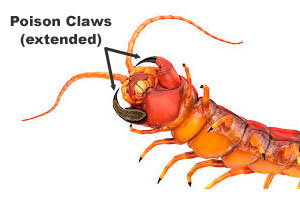
A centipede bite can range from barely noticeable to extremely painful. Many people compare it to feeling like a bee sting. Unless you are allergic to the venom or are in very poor health, a centipede bite isn’t particularly harmful. Children bitten by a large centipede may have a serious reaction and need medical treatment. You can learn more about how poisonous centipedes are in this article.
Desert Centipedes
Giant Desert Centipede
The giant desert centipede is the largest centipede in North America and can grow up to eight inches in length. Most have orange bodies with black heads and tails. However, they can also have a darker body and a red head. They’re known as the giant redheaded centipede or Texas redheaded centipede in some areas. These centipedes live in woodland areas as well as deserts.
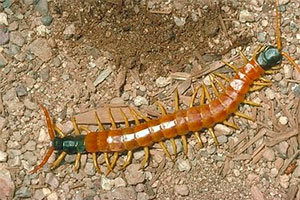
Common Desert Centipede
The common desert centipede is smaller and averages around four inches in length. Their bodies range in color from browns to oranges. Their heads can be brown, red, or orange. They are distinguished from other centipedes by their body stripes, which have led to names like tiger centipede and banded centipede.
Both desert centipedes will bite humans if disturbed or provoked. Both have venomous bites that can be painful.
Stone Centipedes
Stone centipedes are less than two inches in length. They live in damp areas such as your garden. You may occasionally find one in the house, simply because it’s too dry outside for it. They have poor eyesight and stay hidden under rocks, mulch, or leaves.

Stone centipedes prefer to escape your notice rather than bite you. They can throw a sticky liquid at you if they feel threatened. Most people ignore them because they’re eating harmful insects, but if one should bite you, treat the wound like any other bite. There’s information here on using centipede repellent to eliminate them.
Giant Centipedes

The giant centipede, known officially as Scolopendra gigantea, lives primarily in rain forests and tropical areas. It grows up to a foot long. Giant centipedes have various body colors with heads of a different color.
They are able to kill large prey, including frogs and small mammals. Their bite can be extremely painful but isn’t fatal despite the large amount of venom they can inject.
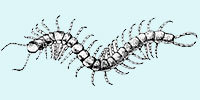
Although the name centipede comes from the Latin for “hundred” and “legs,” centipedes don’t have exactly one hundred legs. Their legs are in pairs, one pair for each segment except for the front and rear segments. It’s hard to tell the front of a centipede from the rear, as both ends have elongated legs.
Their legs allow centipedes to move very quickly. All those legs and the rapid movement are what frighten people. It’s thought that the two pairs of extra-long legs keep centipedes from tripping over themselves as they scuttle about.
What Are House Centipedes?
House centipedes come inside looking for food. Humans are not prey for them. They like insects smaller than they are that they can jump on. If you have an infestation of house centipedes, you likely have other pests that attract them. There is more information here about what attracts centipedes.
They immobilize their meals with their legs and inject venom when necessary. They bite people only in defense. Their claws are not as strong as some other centipedes, and they aren’t able to make deep punctures.

They Are Little and Fast
House centipedes are small. The bodies are rarely more than an inch long, but their legs make them look longer. Their bodies are usually a shade of yellow, with three darker stripes running lengthwise. The legs also have dark stripes. House centipedes have good vision, unlike the other species of centipedes.
Like most centipedes, house centipedes move very quickly. They may dart toward you, but that’s because your clothing can look like a hiding place. They aren’t attacking you despite the appearance.
Symptoms of a Bite
A house centipede can’t bite you very hard because their pincers aren’t large enough to inflict much damage to human skin. You’ll likely just notice a small red bump. If you’re allergic to any insect bites, you may need to seek medical attention.
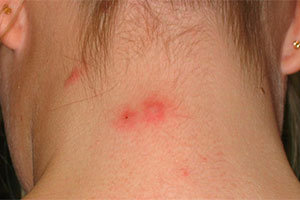 Symptoms include, but aren’t limited to:
Symptoms include, but aren’t limited to:
- Blisters
- Itching
- Redness
- Swelling
For most people, the symptoms disappear within two days, if not within hours.

Centipedes prey on most other insects, including: Ants, Cockroaches, Silverfish, Spiders, Termites, Worms.
Centipedes use their legs to subdue their food before injecting venom.
Centipedes enter your home only to eat other bugs. An infestation of house centipedes is a signal that you have a problem with other pests.
How Can I Tell If a Centipede Bit Me?
If bitten by a centipede, you’ll probably see punctures where the centipede’s claws pierced your skin. There will be a minimum of two wounds, but you could have several. If you have a group of punctures, they may be in a circular pattern. Snakes or other insects can leave punctures that appear similar. You generally know what bit you because you’ll see whatever it was.
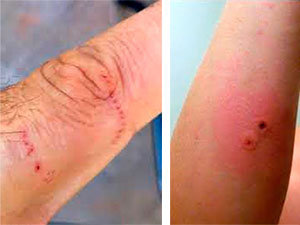 You may see what looks like bruising around the punctures. Some people experience minimal bleeding.
You may see what looks like bruising around the punctures. Some people experience minimal bleeding.
Centipede bites affect everyone differently:
- The depth of the punctures and size of each will depend on the size of the centipede.
- The amount of swelling or redness in the bite area also depends on the centipede, as well as your sensitivity to the venom.
What Happens
The first symptom you’ll notice if a centipede bites you is pain. It’s usually a sharp sensation that may quickly subside. In some cases, the area may continue to hurt for a couple of days. Short-lived or long-lasting, the pain tends to radiate outwards from the bite.
Symptoms to Watch For
- Common symptoms: Blisters, numbness, redness and swelling, tenderness in the bite area
- Additional symptoms: Anxiety, headache
- Allergic reaction symptoms: Difficulty breathing, dizziness, fatigue, fever, nausea, palpitations
Depending on the severity of the symptoms, you may need to consult a healthcare professional.

A serious, but very rare, complication is necrosis, which is when your cells die from infection or trauma. Gangrene can result if necrosis is left untreated.
When to Seek Medical Attention
While most centipede bites can be treated at home, you should seek immediate medical care if you experience:
- Difficulty breathing or swallowing
- Severe swelling that spreads beyond the bite area
- Signs of infection such as increasing redness, warmth, or pus
- Fever over 100.4°F (38°C)
- Persistent pain that doesn’t improve with over-the-counter medications
For more information about when to seek medical attention for centipede bites, see Medical News Today’s comprehensive guide.
How Do I Treat a Bite?
After cleaning the area where the centipede bit you, apply cold to the bite. You can use cold water or an ice pack. The coldness will constrict your blood vessels, which will prevent the spread of the venom.
Over-the-Counter Medications

- Antihistamines
- Aspirin or other non-steroidal pain killers
- Anti-anxiety products
- Anti-inflammatory products
If you consult a doctor, you may receive prescription medications, including antibiotics to prevent infection.
First Aid
The most important thing you can do for a centipede bite is keep the wound clean. If you have meat tenderizer on hand, apply a small amount to the wound. You can also use papaya pulp.

Both contain an enzyme that neutralizes centipede venom.
A hot compress relieves pain for most individuals if there is no swelling. If you have swelling and pain, you may find that a cold compress or ice pack provides more relief.
Centipedes do not have stingers and leave nothing in the puncture for you to remove. Unless you experience symptoms of an allergic reaction to the bite, medical intervention is rarely necessary.
For the most part, centipedes don’t bite people. They prefer to put their energy into killing their prey. Their appearance is startling, and it’s natural to want to kill one when you see it in your home. If you’re able to eliminate the destructive pests, such as termites, that the centipedes eat, your problem with centipedes will go away. A centipede bite is rarely serious, and you can safely regard it as no different from any other insect bite.
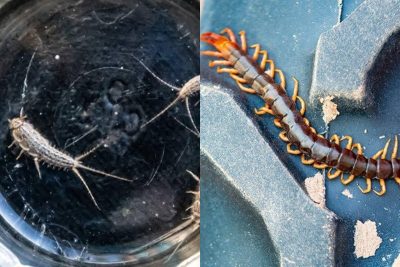
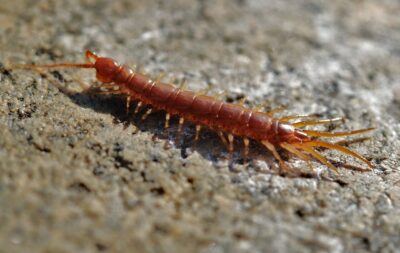

Thanks very helpfull
To those people who have posted asking things like, “am I going to die?” You need to just go see a doctor. If you are in severe pain from anything and really think it could be serious, take the time, money, whatever, and go get help. If you’re in USA, you can find a doctor that’ll see you. This is not the place to ask for help. I realize the comments I saw are old, but in case you see this in the future: go to a doctor.
Mam/sir , I do not know whether a centipede has bitten me or not but it is hurting
Pls help am I going to die
Does a centipede bite make it look like a pimple with similar white pus but a little different, not so solid in form. Two holes in the buttocks area that now has dried up in sunken the area which now looks like blackheads but not. My mother-in-law is bedridden and experiencing a lot of itching over a 2-3 week. We don’t know the cause, wondering if it could have been buy a house centipede bite. We have found house centipedes in our home. Benadryl work After experiencing itching for two days it went away then came back with a vengeance and Benadryl would not take the itching away and now she’s on a prescription drug for the itch. We have ruled out many things. Just wondering if a bite can cause this itching?
-this is an old thread but we still have issues with these guy-house centipedes
They come around when it is warm and rainy. They can bite and leave red itchy spot/sticky area. Have been bitten a few times over the years and it took a couple weeks for the redness and itching to go away on me. You could spray some eucalyptus or peppermint oil around the perimeter of the bed (and on walls about bed) to possibly deter them.
been bed-ridden for a week. lost my job. whole leg is swollen. cant see a doctor, because i am white.
i am so sorry hope you make it 🙂
Please my right hand is swollen and reddish, with excruciating pains.
I do not know if I was bitten by a centipede.
It all started two days ago, last Tuesday when I woke up, I saw a reddish pattern on my right hand, that evening it started itching me, the following Wednesday morning it had swollen, today Friday it is dropping some yellowish water. I think it is infected.
Please help me sir/madam.
I’m I going to die?
To relieve your pain, clean the affected area and proceed to use something cold to reduce the pain and venom from spreading. Visit a doctor immediately.